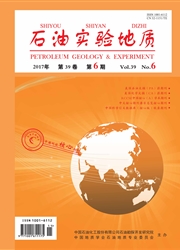

 中文摘要:
中文摘要:
受多期构造叠加、多期生烃和多期成藏的影响,准噶尔盆地腹部地区多数油气藏经历了不同程度的调整改造,形成了有成因联系的一系列调整改造型隐蔽油气藏。分析古油藏中原油残留、残余、散失或再聚集成藏的主控因素,查明油气藏再分布规律,是油气勘探的根本保证,二维模型物理模拟实验较好地再现了不同类型隐蔽油气藏调整过程中原油的再分布情况。实验结果表明:1)油气藏调整过程中,物性较好的储层部分含油饱和度降低明显,甚至由油层变为水层,而物性较差的储层含油饱和度变化较小,呈现出差异残留或差异再运移的特征;2)同向与反向调整型油气藏其形成与再分布规律有一定差别;3)调整后的油气藏呈分散状、小规模分布,其成藏类型由以构造圈闭为主变成以地层/岩性圈闭为主。
 英文摘要:
英文摘要:
In superimposed basins, such as hinterland of J unggar Basin, the formerly accumulated subtle reservoirs usually have undergone adjustment due to the stack of multiple-stage tectonic movements,generation and accumulation. Studying mainly control factors of adjustment for formerly accumulated reservoirs and understanding their re-distribution rules, which are a primary guaranty of petroleum exploration. 2-D physical model experiment ideally recurred adjustment process and result of variously adjusted subtle oil-gas reservoirs. The following results have been obtained: 1) Due to reservoirs adjustment, the oil saturation of reservoir depressed obviously for its fine physical property; Some reservoirs turned into water layers indeed; while, the oil saturation of the one for bad physical property depressed less. The characteristic of different remain or different migration has been presented; 2) The complexion of formation and distribution of concordant and converse adjusted reservoirs exists some difference; 3)The adjusted reservoirs are dispersed and small-area distribution, and their trap types are mainly stratigraphic and lithologic traps instead of structural traps.
 同期刊论文项目
同期刊论文项目
 同项目期刊论文
同项目期刊论文
 期刊信息
期刊信息
